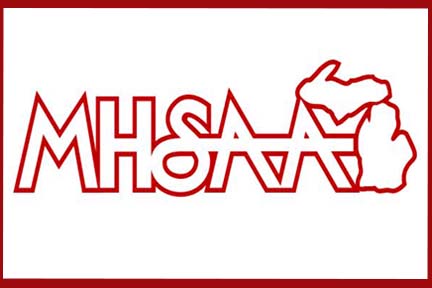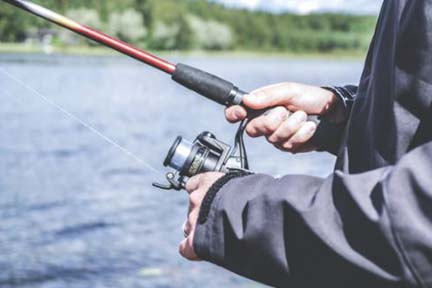Showcasing the DNR
By JOHN PEPIN
Michigan Department of Natural Resources
When I was a young kid growing up, I remember my dad had two fishing rods and reels he prized that I wasn’t allowed to touch.
One was for plunking worms into streams and creeks for brook, brown and rainbow trout. It was an old baitcasting rod that was shiny white, with yellow, black and red windings that held the silver guides in place.
The reel was silver and bore black, thick line that felt like a shoelace. The chrome on both sides of the reel was etched with a cool scene depicting two anglers in a boat, one with a fish on his line and the other moving a net into place.
The handles of the reel had a swirly design of deep brown set over a reddish-brown background. I was fascinated with this reel, and I still am. I have spent more than a few times studying the craftsmanship of the reel, turning it over, from side to side, in my hand.
When the line is pulled out, with the drag set, the reel makes a clicking sound I must have heard hundreds of times, if not more. I find the sound very comforting. I think it must be deep-seated in my being.
Some of my earliest memories of fishing include these types of reels that my dad and mom both used. My mom used to fish and hunt partridge with my dad, back in the days when we had an old 1960’s, white Chevrolet Impala.
The second fishing pole my dad had was a yellow Eagle Claw rod of more significant strength, used for fishing Lake Superior from shore. In the fall, the rod would be used angling for spawning coho and chinook salmon in local tributaries to the big lake.
My dad and his fishing buddy, a co-worker friend from his job at the post office, would also catch lake trout and the occasional coaster brook trout casting Little Cleos from the rocky ledges along those famously deep, cold waters.
They would often go fishing, but I was never allowed to come along. Most of the time, it was because I was in school when they would go out on Thursdays, my dad’s weekday off.
I remember often getting my hopes up. I used to think I should have been given a reprieve from school for the obviously important and hallowed activity of trout and salmon fishing.
No dice, kid.
Beyond school, I think my dad needed to have some quiet time fishing away from his job and the pressures of a household with a wife and four kids. I can see that easier now than I did back then.
The reel he used for this more substantial, though still considered intermediate, fishing rod was a Garcia Mitchell 306, open-faced spinning reel. This was a reel first issued in 1958, along with a similar 307 left-handed version for southpaws – like me.
I remember thinking that this reel looked massive to my young kid eyes – like it could haul in a shark.
I was used to the basic simplicity of a Zebco 202 rod and reel combo. These rods were inexpensive and available from the Coast-to-Coast hardware store a few blocks from home, downtown.
The rods were anything but kid-proof, prone to snapping easily, or having their tip-top guide broken off when encountering even the most basic kid calamities, like getting the pole stuck in the spokes of your bicycle wheel, or accidentally dragging the rod tip on blacktop when riding to the creek.
Thirteen years ago, this month, my dad died.
I have had his Eagle Claw rod and reel tucked away in storage since then, never using it once. I still have his baitcasting reel too, but I don’t know what happened to the rod that went with it. He didn’t have it during those latter years of his life.
I would never think of using the baitcasting reel. It’s too precious to me. It’s like a fine old pocket watch or compass, something possessing the mechanical secrets and craftsmanship of a bygone age.
It still bears the thick black line, and the etched fishing scene still glimmers.
Recently, after a good deal of agonizing, I decided that my dad would probably have wanted me to use his fishing rod now that he wasn’t needing it any longer.
I took it out for some Lake Superior casting, with a former co-worker friend of my own.
I removed the old, brittle line and replaced it. I fastened the reel to a different rod, leaving the Eagle Claw at home on the fishing rack. I would be crushed if I somehow damaged it.
Everything was working fabulously. The reel was performing well, launching my lure far out into the lake, then dragging it back smoothly and deeply on the retrieve.
All afternoon, I never got a bite, but it had been a long winter, already a long quarantine and a glorious afternoon out in the sunshine.
Before going home, my friend and I worked the mouth and far reaches of one of the tributaries, looking for an early and hungry spring steelhead.
Again, things were going swimmingly.
And then, unexpectedly, the line got caught underneath the spool and wrapped around the shaft of the reel. I hate when this happens.
I had to unscrew the cap shaft to lift out the spool to unwrap the line. When I did, the cap slipped between my fingers and fell to the ground. Like a camera lens cap I remember well from a bridge in Ontonagon County, it rolled a long, slow roll before plopping into the river.
The cap sunk out of sight, along with the brilliance of the idea to have used my dad’s fishing reel. I felt like an idiot. I also felt sorry.
At home, I decided to search Ebay for a replacement part for the reel. I found not only a spool, with an attached drive cap, but it also came with an original manual for the reel. The cost was only $12.
I got to thinking that the reel probably hadn’t been greased properly or oiled since who knows when. I didn’t know the manual would show me exactly how to do this, with pictures and everything.
So, while I waited for the mailman, I found a great tutorial on YouTube showing me the steps involved. I found pride in taking apart this reel, learning about it and digging out the old grease, which looked like Bit-O-Honey candy more than reel gear lubricant.
I employed the assistance of the Mool and the Tater – those tenacious twin stepdaughter teens of mine – to help me clean and dry the parts after I had taken the reel apart.
I was able to reassemble the reel with the help of the video, except for one tiny step that was missing because the man in the video moved his hand out of view of the camera, just at the precisely wrong time.
So, I waited a couple more days for the spool and manual to arrive. I was so excited to get that box in the mail. However, the excitement was short-lived when I realized the seller had forgotten to include the manual. One email and a few more days later, it arrived as splendidly as the Queen Mary.
The Mool and I pieced the reel back together. I think this was a nice time spent for both of us. Now, cleaned and restored, the reel is spinning freely and is ready for the next adventure.
Though I felt so embarrassed to have dropped the reel top, the experience that followed showed me things I wouldn’t have expected.
In a very tangible way, I realized the respect I still possess for my dad and his old fishing reel. I still felt responsible to fix something that wasn’t mine to break.
I felt my love for my dad as I took time and care to disassemble, grease and repair the fishing reel. I sensed that I was still honoring him, while passing on that example to my young stepdaughter.
It’s strange how life has lessons to teach even after you’re gone.
Check out previous Showcasing the DNR stories in our archive at Michigan.gov/DNRStories. To subscribe to upcoming Showcasing articles, sign up for free email delivery at Michigan.gov/DNR.
/Note to editors: Contact: John Pepin, Showcasing the DNR series editor, 906-226-1352. Accompanying photos and a text-only version of this story are available below for download. Caption information follows. Credit Michigan Department of Natural Resources, unless otherwise noted.
Text only version – Reeling in the years
Reel: An old bait-casting reel with a fishing scene etched into the side from Dad’s old collection of fishing tackle./ |




















